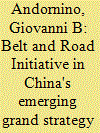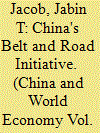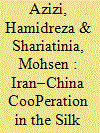|
|
|
Sort Order |
|
|
|
Items / Page
|
|
|
|
|
|
|
| Srl | Item |
| 1 |
ID:
155247


|
|
|
|
|
| Summary/Abstract |
This paper analyzes the impact of the Belt and Road Initiative on Europe with a specific focus on Italy. We concentrate on the impact of new railways and port infrastructures on bilateral trade. Our analysis suggests that the development of new railway connections will benefit most of the Northern and Central European countries. Some industries like automotive and electronics that have a higher value to weight ratio will benefit more than others. However, due to higher costs, railway services will never reach a high percentage of total import/export flows. Investment in new port facilities, although less “new” compared with railways, may be a bigger game changer. The development of the Port of Piraeus has already increased the importance of the Mediterranean Sea as an import/export hub for China. If the other planned investments in Egypt and Algeria are completed, this phenomenon will be magnified. This presents a huge challenge for Italy. The Italian port in the high Adriatic Sea could be displaced by Piraeus capacity, especially if this port is linked through railways with the center of Europe. Italy needs to coordinate its ports together with its railway network to take advantage of Belt and Road Initiative opportunities.
|
|
|
|
|
|
|
|
|
|
|
|
|
|
|
|
| 2 |
ID:
155240


|
|
|
|
|
| Summary/Abstract |
As Chinese leaders endeavor to maintain the international environment aligned with their strategic aim of realizing the “dream of national rejuvenation,” the remarkable increase in China's capabilities, coupled with uncertainty in the global economy and the ambivalent attitude of the USA toward the international order, poses fresh challenges to Beijing's foreign policy. The present paper argues that a lexicographic preference for the mitigation of the risk of pushback against China's core interests underpins the Belt and Road Initiative. Pursuing a strategy of credible reassurance commensurate to the shift in the distribution of power in China's neighborhood and globally, President Xi Jinping's administration has been cultivating a form of connective leadership that commits China to the encapsulation of the Belt and Road Initiative for transregional connectivity into its own national development strategy, generating an octroyé, non-hegemonic, type of international social capital, and integrating the existing order without corroborating the position of its founder.
|
|
|
|
|
|
|
|
|
|
|
|
|
|
|
|
| 3 |
ID:
155245


|
|
|
|
|
| Summary/Abstract |
China's Belt and Road Initiative (BRI) is often simplistically understood as being opposed by India and supported by Pakistan. The reality on the ground is rather more complex. The emerging consensus in India appears to be that, far from being exclusively an economic and infrastructure development program, the BRI may be understood as a long-term strategic initiative that seeks to convert China's current economic might into diplomatic influence. While attempts have been made by Beijing, the reflexive Indian suspicion of Chinese international projection, including of China's BRI, has not yet been met by a coherent discourse designed to specifically address Indian concerns. In contrast, in Pakistan, widespread acceptance of the importance and necessity of the China–Pakistan Economic Corridor is increasingly coupled with concerns within sectors of Pakistani society over the fairness, transparency and eventual economic outcomes of the project. Accordingly, this paper is divided into two parts: the first looks at how Indian analysts have viewed and responded to the Chinese discourse and arguments on the BRI; the second considers the debate over the China–Pakistan Economic Corridor within Pakistan.
|
|
|
|
|
|
|
|
|
|
|
|
|
|
|
|
| 4 |
ID:
155246


|
|
|
|
|
| Summary/Abstract |
This paper provides an overview of China's burgeoning relationship with Central, East and Southeast Europe (CESEE) in the context of the Belt and Road Initiative (BRI). China has rapidly expanded the extent of its interactions with CESEE since 2012, and this region has subsequently become one of the focal points of the BRI. The key feature of China's engagement with CESEE is the devising of an experimental and innovative approach, demonstrated in the establishment of an institutional mechanism for cooperation with a particular group of 16 CESEE countries (16+1). The case of China–CESEE relations offers an insight into how, in the era of the BRI, China is complementing its economic approach with institution-building and policy coordination. The article concludes that as the BRI progresses, these tendencies will remain central to China's relations with CESEE.
|
|
|
|
|
|
|
|
|
|
|
|
|
|
|
|
| 5 |
ID:
155241


|
|
|
|
|
| Summary/Abstract |
China's Belt and Road Initiative (BRI) is, above all, a connectivity project. As connectivity requires financial support, in the past few years China has undertaken several institution-building activities at the national and international level, mainly in the financial and economic sector, showing a new propensity to influence global economic governance. In particular, the establishment of the Asian Infrastructure Investment Bank (AIIB) has drawn attention worldwide. How does this institution-building process connect with BRI? Are these institutions just a vehicle for exporting China's capital and overcapacity, or do they signal a potential wider challenge to the post-World War II liberal international order? By analyzing the first loans approved by the bank, the present paper argues that far from representing a China-led challenge to the Western-led liberal order, the AIIB, while promoting Chinese commercial and geopolitical interests, shows the resilience of the global financial regime created by the West.
|
|
|
|
|
|
|
|
|
|
|
|
|
|
|
|
| 6 |
ID:
155242


|
|
|
|
|
| Summary/Abstract |
Iran served as a bridge in the ancient Silk Road, connecting the East and the West. It also has great potential to play an important role in the new Silk Road. The present study analyzes the factors affecting Iran–China cooperation in the context of the Belt and Road Initiative at the strategic and operational levels. This article shows that, at the strategic level, Iran defines this project as an opportunity to improve its status in the world economy, expanding its room to manoeuvre in the international arena and developing its ties with China, a rising great power. At the operational level, the opportunities and challenges for Iran–China cooperation could be summarized as pertaining to five realms within the Silk Road Economic Belt Initiative: policy coordination, facilitation of connectivity, unimpeded trade, financial integration and people-to-people bonds. The present study asserts that the main opportunity for cooperation between the two countries lies in facilitating connectivity and that the key challenge is financial integration.
|
|
|
|
|
|
|
|
|
|
|
|
|
|
|
|
| 7 |
ID:
155243


|
|
|
|
|
| Summary/Abstract |
The article aims to highlight Russian approaches to Chinese One Belt-One Road initiative. It examines possible opportunities and challenges for co-development of the Eurasian Economic Union and the Belt project. Both projects and their co-development may reduce the uncertainty in Eurasia, caused by significant structural changes in international relations and the world economy, the emergence of new trade regimes and the erosion of leadership in international affairs. Russian interests in this regard are determined by the need for modernization and long-term development, which could also help to address acute security issues. These particular factors encouraged Russia to come up with an ambitious plan of the Extensive Eurasian Partnership, although the prospects of its implementation currently are uncertain. The present article argues that the success of Russia-China collaboration in Eurasia will depend crucially on the future dynamics of the Eurasian integration, as well as on the agreement to co-develop the Eurasian Economic Union and the Belt Initiative with concrete and mutually beneficial projects.
|
|
|
|
|
|
|
|
|
|
|
|
|
|
|
|
| 8 |
ID:
155244


|
|
|
|
|
| Summary/Abstract |
The article aims to highlight Russian approaches to Chinese One Belt-One Road initiative. It examines possible opportunities and challenges for co-development of the Eurasian Economic Union and the Belt project. Both projects and their co-development may reduce the uncertainty in Eurasia, caused by significant structural changes in international relations and the world economy, the emergence of new trade regimes and the erosion of leadership in international affairs. Russian interests in this regard are determined by the need for modernization and long-term development, which could also help to address acute security issues. These particular factors encouraged Russia to come up with an ambitious plan of the Extensive Eurasian Partnership, although the prospects of its implementation currently are uncertain. The present article argues that the success of Russia-China collaboration in Eurasia will depend crucially on the future dynamics of the Eurasian integration, as well as on the agreement to co-develop the Eurasian Economic Union and the Belt Initiative with concrete and mutually beneficial projects.
|
|
|
|
|
|
|
|
|
|
|
|
|
|
|
|
|
|
|
|
|